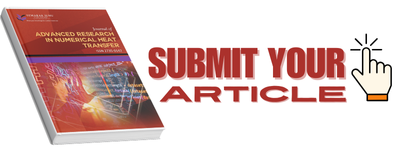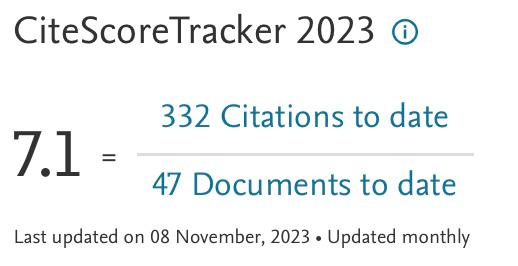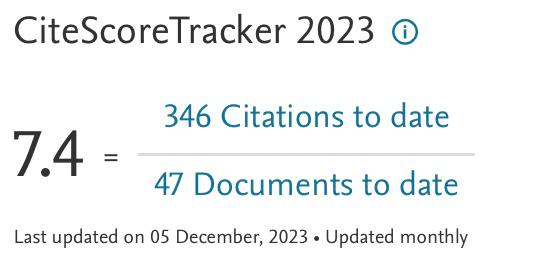Analysis of the Effect of Tortuosity Porous Heatsink on Force Convection Heat Transfer
DOI:
https://doi.org/10.37934/arnht.16.1.5769Keywords:
Heatsink, Tortuosity, Force Convection, Computational Fluid DynamicsAbstract
The improvement of performance in modern electronic devices has driven rapid advancements in the field of thermal management. Excessive heating of electronic components can lead to damage and decreased device performance. This research aimed to analyze the effect of tortuosity porous heatsink on force convection heat transfer. Computational fluid dynamics methodology was used to model airflow and the distribution of temperature, velocity, convective heat transfer coefficient, and turbulence kinetic energy (TKE) in heatsinks with varying tortuosity levels. Results show that tortuosity has a positive linear correlation with heatsink surface area and pressure drop. However, it has a negative linear correlation with surface heat transfer coefficient (SHTC). When the tortuosity increases, the surface area increases from 9298.48 mm2 to 12711.93 mm2, and the pressure drop increases from 19.587 Pa to 24.296 Pa. By contrast, the surface heat transfer coefficient decreased significantly from 41.1214 W m-2 K-1 to 30.8454 W m-2 K-1. This study also shows that heatsinks with low tortuosity have a more uniform distribution of temperature, velocity, and TKE, resulting in higher cooling efficiency. Thus, we conclude that tortuosity is an important factor in heatsink design and optimization, and a suitable level of tortuosity should be achieved
Downloads
References
Almubarak, Adel Ahmed. "The effects of heat on electronic components." Int. J. Eng. Res. Appl 7, no. 5 (2017): 52-57. https://doi.org/10.9790/9622-0705055257
Hoque, Muhammad Jahidul, Alperen Günay, Andrew Stillwell, Yashraj Gurumukhi, Robert CN Pilawa-Podgurski, and Nenad Miljkovic. "Modular heat sinks for enhanced thermal management of electronics." Journal of Electronic Packaging 143, no. 2 (2021): 020903. https://doi.org/10.1115/1.4049294
Zhou, Jinzhi, Xiaoling Cao, Nan Zhang, Yanping Yuan, Xudong Zhao, and David Hardy. "Micro-channel heat sink: a review." Journal of Thermal Science 29 (2020): 1431-1462. https://doi.org/10.1007/s11630-020-1334-y
Sarap, Martin, Ants Kallaste, Payam Shams Ghahfarokhi, and Toomas Vaimann. "Analysis of Advanced Passive Heatsinks For Electrical Machines Enabled by Additive Manufacturing." In 2023 IEEE Workshop on Electrical Machines Design, Control and Diagnosis (WEMDCD), pp. 1-6. IEEE, 2023. https://doi.org/10.1109/WEMDCD55819.2023.10110940
Özdilli, Özgür. "Design and thermal performance analysis of different type cylindrical heatsinks." International Journal of Thermal Sciences 170 (2021): 107181. https://doi.org/10.1016/j.ijthermalsci.2021.107181
Kore, Sandeep S., Rupesh Yadav, Satish Chinchanikar, Pralhad Tipole, and Vishal Dhole. "Experimental investigations of conical perforations on the thermal performance of cylindrical pin fin heat sink." International Journal of Ambient Energy 43, no. 1 (2022): 3431-3442. https://doi.org/10.1080/01430750.2020.1834451
Zapach, Trevor, Todd Newhouse, Jeff Taylor, and Peter Thomasing. "Experimental verification of a model for the optimization of pin fin heatsinks." In ITHERM 2000. The Seventh Intersociety Conference on Thermal and Thermomechanical Phenomena in Electronic Systems (Cat. No. 00CH37069), vol. 1, pp. 63-69. IEEE, 2000.
White, Andrew Scott, David Saltzman, and Stephen Lynch. "Performance analysis of heat sinks designed for additive manufacturing." In International Electronic Packaging Technical Conference and Exhibition, vol. 84041, p. V001T07A003. American Society of Mechanical Engineers, 2020. https://doi.org/10.1115/IPACK2020-2532
Silva, Eva C., Álvaro M. Sampaio, and António J. Pontes. "Evaluation of active heat sinks design under forced convection—effect of geometric and boundary parameters." Materials 14, no. 8 (2021): 2041. https://doi.org/10.3390/ma14082041
Baobaid, Nada, Mohamed I. Ali, Kamran A. Khan, and Rashid K. Abu Al-Rub. "Fluid flow and heat transfer of porous TPMS architected heat sinks in free convection environment." Case Studies in Thermal Engineering 33 (2022): 101944. https://doi.org/10.1016/j.csite.2022.101944
Ali, Mohamed I. Hassan, Oraib Al-Ketan, Mohamad Khalil, Nada Baobaid, Kamran Khan, and Rashid K. Abu Al-Rub. "3D printed architected heat sinks cooling performance in free and forced convection environments." In Heat Transfer Summer Conference, vol. 83709, p. V001T09A012. American Society of Mechanical Engineers, 2020. https://doi.org/10.1115/HT2020-9067
Prakoso, Akbar Teguh, Hasan Basri, Dendy Adanta, Irsyadi Yani, Muhammad Imam Ammarullah, Imam Akbar, Farah Amira Ghazali, Ardiyansyah Syahrom, and Tunku Kamarul. "The effect of tortuosity on permeability of porous scaffold." Biomedicines 11, no. 2 (2023): 427. ttps://doi.org/10.3390/biomedicines11020427
Basri, Hasan, Akbar Teguh Prakoso, Zainal Abidin, Ardiansyah Syahrom, Imam Akbar, and Dendy Adanta. "The Effect of Tortuosity on Wall Shear Stress of Porous Scaffold." CFD Letters 15, no. 7 (2023): 61-73. https://doi.org/10.37934/cfdl.15.7.6173
Cooper, Samuel J., Antonio Bertei, Paul R. Shearing, J. A. Kilner, and Nigel P. Brandon. "TauFactor: An open-source application for calculating tortuosity factors from tomographic data." SoftwareX 5 (2016): 203-210. https://doi.org/10.1016/j.softx.2016.09.002
Fu, Jinlong, Hywel R. Thomas, and Chenfeng Li. "Tortuosity of porous media: Image analysis and physical simulation." Earth-Science Reviews 212 (2021): 103439. https://doi.org/10.1016/j.earscirev.2020.103439
Kim, Dong-Kwon, Sung Jin Kim, and Jin-Kwon Bae. "Comparison of thermal performances of plate-fin and pin-fin heat sinks subject to an impinging flow." International Journal of Heat and Mass Transfer 52, no. 15-16 (2009): 3510-3517. https://doi.org/10.1016/j.ijheatmasstransfer.2009.02.041
Freegah, Basim, Ammar A. Hussain, Abeer H. Falih, and Hossein Towsyfyan. "CFD analysis of heat transfer enhancement in plate-fin heat sinks with fillet profile: Investigation of new designs." Thermal Science and Engineering Progress 17 (2020): 100458. https://doi.org/10.1016/j.tsep.2019.100458
Bataineh, Ahmad, Wafa Batayneh, Ahmad Al-Smadi, and Baian Bataineh. "Ladder Heat Sink Design Using Adaptive Neuro-Fuzzy Inference System (ANFIS)." Financed by Scientific Research Support Fund 13, no. 1 (2019): 27.
Huang, Cheng-Hung, Jon-Jer Lu, and Herchang Ay. "A three-dimensional heat sink module design problem with experimental verification." International Journal of Heat and Mass Transfer 54, no. 7-8 (2011): 1482-1492. https://doi.org/10.1016/j.ijheatmasstransfer.2010.11.044
Mohan, R., and P. Govindarajan. "Experimental and CFD analysis of heat sinks with base plate for CPU cooling." Journal of mechanical science and technology 25 (2011): 2003-2012. https://doi.org/10.1007/s12206-011-0531-8
Rao, Dengyu, and Bing Bai. "Study of the factors influencing diffusive tortuosity based on pore-scale SPH simulation of granular soil." Transport in Porous Media 132 (2020): 333-353. https://doi.org/10.1007/s11242-020-01394-0
Subramani, Shanmugan, and Mutharasu Devarajan. "Influence of extended surface area of heatsink on heat transfer: design and analysis." Microelectronics International (2023). https://doi.org/10.1108/MI-09-2022-0171
Liu, Xiaobang, Yanxiang Li, Huawei Zhang, Yuan Liu, and Xiang Chen. "Effect of pore structure on heat transfer performance of lotus-type porous copper heat sink." International Journal of Heat and Mass Transfer 144 (2019): 118641. https://doi.org/10.1016/j.ijheatmasstransfer.2019.118641
Grigull, Ulrich, and Heinrich Sandner. Heat conduction. Vol. 7. Berlin: Springer-Verlag, 1984. https://doi.org/10.1007/978-3-642-96816-7_2
Ahn, J., Ephraim M. Sparrow, and John M. Gorman. "Turbulence intensity effects on heat transfer and fluid-flow for a circular cylinder in crossflow." International Journal of Heat and Mass Transfer 113 (2017): 613-621. https://doi.org/10.1016/j.ijheatmasstransfer.2017.05.131
El-Okda, Yasser M., and Ghassan Nasif. "Conjugate Effect on the Heat Transfer Coefficient." Journal of Advanced Research in Numerical Heat Transfer 5, no. 1 (2021): 1-8.
Saadoon, Zahraa H., Farooq H. Ali, Hameed K. Hamzah, Azher M. Abed, and M. Hatami. "Improving the performance of mini-channel heat sink by using wavy channel and different types of nanofluids." Scientific Reports 12, no. 1 (2022): 9402. https://doi.org/10.1038/s41598-022-13519-0
Yeranee, Kirttayoth, and Yu Rao. "A review of recent investigations on flow and heat transfer enhancement in cooling channels embedded with triply periodic minimal surfaces (TPMS)." Energies 15, no. 23 (2022): 8994. https://doi.org/10.3390/en15238994
Stull, Roland B. An introduction to boundary layer meteorology. Vol. 13. Springer Science & Business Media, 2012.
Grošelj, Daniel, Christopher HK Chen, Alfred Mallet, Ravi Samtaney, Kai Schneider, and Frank Jenko. "Kinetic turbulence in astrophysical plasmas: waves and/or structures?." Physical Review X 9, no. 3 (2019): 031037. https://doi.org/10.1103/PhysRevX.9.031037


























